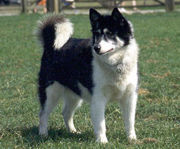|
The Canine Chronicles Directory
Canadian Eskimo Dog

The Canadian Eskimo Dog is also known as the Gronlandshund (Greenland Dog), Inuit
Husky and is called "Qimmiq" by the Inuit. The skull is broad and slightly arched,
with a definite stop. The large nose is dark and corresponds to the coat color.
It may turn pink during the winter. The muzzle is wedge-shaped, broad at the base
and tapers towards the nose. The lips are thin and tight and lie close to the power
teeth. The preferred eye color is dark, but any color is accepted. The small ears
are triangle in shape, with rounded tips and are carried erect. The short neck is
powerful and the topline is level or slightly sloping. The tail is set high, is
thick and bushy, and is carried in a curve or curl over the back. The large feet
are powerful and rounded, with strong nails and pads. The double-thick coat has
a soft, dense undercoat and a straight and coarse outercoat. The hair on the head
and legs is shorter than is found on the body. Any color is permitted with this
breed except albinos.
|
|
Temperament
|
The Canadian Eskimo Dog is alert, curious and very intelligent. They are easy to
train and once commands are learned, they are never forgotten. They have a phenomenal
memory. They have a zest for life as well as a gentle disposition. This breed makes
wonderful companions for the active or outdoors minded. This hard-working breed
is for the serious musher or the recreational team. This rugged breed is playful
and submissive. The natural voice is a howl, instead of a bark. When in a group,
the dogs often give voice in a chorus of strangely woven tones and is one of the
thrilling sounds of the Arctic. The CED is not as stubborn as other northern breeds,
nor is he prone to wander. They can be very dog aggressive. Firm handling and training
is required.
|
|
Height, Weight
|
Male Height: up to 28" ; Weight: 65-85 lbs.
Female Height: up to 20" ; Weight: 40-65 lbs.
|
|
Health Problems
|
They are prone to hip dysplasia and retinal atrophy. The coat should be kept free
of fleas as they can cause dermatitis.
|
|
Living Conditions
|
The CED is not suited to indoor living, nor to hot climates.
|
|
Exercise
|
This breed requires abundant daily exercise as well as a job to do.
|
|
Life Expectancy
|
About 12-13 years
|
|
Grooming
|
Regular brushing is required.
|
|
Origin
|
Originating in the arctic, this breed was selected for thousands of years by Eskimos
for their energy and power. P. E. Victor introduced the breed to the world in 1936
when he brought back the dogs used for his polar expeditions. This Spitz-type breed
has northern wolf blood. By the 1970s, the breed number had dropped to less than
200. A project headed by William Carpenter and funded by the CKC, private Canadian
citizens and the Canada council saved the breed from extinction. They are recognized
by the UKC.
|
|
Group
|
Northern
|